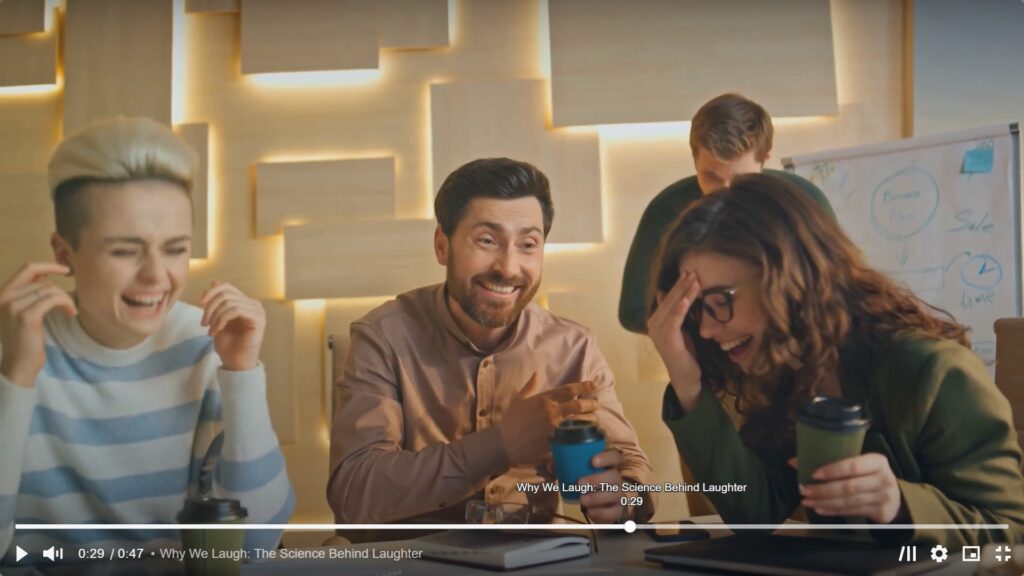Explore the common scientific theories about why humans laugh, and how this universal behavior evolved.
Watch the video and fill in the gaps in the sentences below:
1. Laughter is a strange phenomenon that involves showing teeth, changing breathing, and even …………………. .
2. Laughter inhibits reflexes and muscle control, leading to sensations like ………………. .
3. Laughter is not exclusive to humans, as at least 65 species, including mammals and birds, vocalize during ………………. .
4. We laugh when we are amused, and even surprised, ………………. or ……………………. .
5. Some scientists hypothesize that laughter gradually became something we could use in speech to convey …………… meanings.
6. Laughter is …………. and can activate key regions in the brain, ……………. you to smile or laugh yourself.
7. Studies found that babies as young as 5 months old could reliably tell the difference between close friends and ………….. just from breif clips of them laughing.
8. Laughter releases feel-good neurotransmitters, decreases stress hormones, and may improve cardiovascular …………… .
Key: 1. crying; 2. leg weakness; 3. social play; 4. confused; nervous; 5. subtle; 6. contagious; triggering; 7. acquaintances; 8. health
Glossary
- abdominal – relating to, or involving the abdomen (=the lower part of a person’s or animal’s body, containing the stomach, bowels)
- to contract – to become smaller or shorter
- wheeze – a high, rough noise made when someone cannot breathe easily
- volitional – done of one’s own will or choosing; deliberately decided or chosen
- ailment – an illness, especially one that is not very serious
- To crack up – to suddenly laugh a lot, or to make someone suddenly laugh a lot
Read the article and choose the right answer a)-d) to the questions below:
https://www.inc.com/sara-deeter/humor-could-make-you-better-leader-supercharge-your-team.html
1. According to the passage, which of the following is a key benefit of incorporating humour and fun in the workplace?
a) It improves employee work-life balance.
b) It increases employee productivity and teamwork.
c) It helps leaders appear more charismatic.
d) It reduces workplace conflicts and disputes.
2. What is the primary reason the passage suggests leaders are hesitant to use humour in the workplace?
a) They believe it can undermine their authority.
b) They worry it will distract employees from their work.
c) They lack confidence in their own comedic abilities.
d) They are concerned it will create an unprofessional atmosphere.
3. The passage recommends a specific strategy to help leaders become more comfortable with using humour. What is this strategy?
a) Observing how other successful leaders incorporate humour.
b) Taking comedy classes to develop their skills.
c) Hiring a professional comedian to train their employees.
d) Writing down three things they find funny each week.
4. According to the passage, what is key to making “fun rituals” successful in the workplace?
a) Ensuring they occur at the same time each day.
b) Involving employees based on their individual interests.
c) Rotating the responsibility for planning the activities.
d) Combining both serious and lighthearted elements.
5. What is the main point the passage makes about the role of humour and fun in creating a great workplace?
a) It is essential for any successful business leader to prioritise.
b) It can help transform a good workplace into a great one.
c) It is more important than traditional employee benefits.
d) It is the single greatest predictor of a company’s workplace quality.
6. Which of the following does the passage suggest as an example of a “fun ritual” in the workplace?
a) Playing a random song at 3 pm each day.
b) Hosting an annual company party.
c) Organising a weekly trivia competition.
d) Encouraging employees to wear costumes.
Key: 1. B; 2. C; 3. D; 4. B; 5. B; 6. A;
Discuss
- Is laughter ‘the best medicine’?
- Do you ever have uncontrollable fits of laughter?
- What social functions does laughter have?
- People can ‘roar’ or ‘howl’ with laughter, and ‘burst into’ or ‘break into’ laughter. What are the differences between these?
Watch and revise!
Why We Laugh: The Science Behind Laughter
https://www.cloud.worldwideschool.pl/index.php/s/DYnWkm2AWgb3BcZ
(5040)






